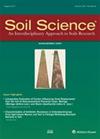Evolutionary pathways in soil-landscape evolution models
4区 农林科学
Q2 Agricultural and Biological Sciences
引用次数: 1
Abstract
Abstract. Soils and landscapes can show complex, non-linear evolution, especially under changing climate or land use. Soil-landscape evolution models (SLEMs) are increasingly equipped to simulate the development of soils and landscapes over long timescales under these changing drivers, but provide large data output that can be difficult to interpret and communicate. New tools are required to analyse and communicate large model output. In this work, I show how spatial and temporal trends in previously published model results can be summarized and conceptualized with evolutionary pathways, which are possible trajectories of the development of soil patterns. Simulated differences in rainfall and land use control progressive or regressive soil development and convergence or divergence of the soil pattern. These changes are illustrated with real-world examples of soil development and soil complexity. The use of evolutionary pathways for analysing the results of SLEMs is not limited to the examples in this paper, but they can be used on a wide variety of soil properties, soil pattern statistics and models. With that, evolutionary pathways provide a promising tool to analyse and communicate soil model output, not only for studying past changes in soils, but also for evaluating future spatial and temporal effects of soil management practices in the context of sustainability.土壤-景观演化模型的演化路径
摘要土壤和景观可以表现出复杂的非线性演变,特别是在气候或土地利用变化的情况下。土壤-景观演变模型(slem)越来越多地用于模拟这些变化驱动因素下土壤和景观在长时间尺度上的发展,但提供的大量数据输出可能难以解释和交流。需要新的工具来分析和交流大型模型输出。在这项工作中,我展示了如何用进化途径总结和概念化以前发表的模型结果中的空间和时间趋势,这是土壤模式发展的可能轨迹。模拟的降雨和土地利用差异控制着土壤的渐进或退化发育以及土壤格局的收敛或分化。这些变化用土壤发育和土壤复杂性的实际例子来说明。使用进化途径分析slem的结果并不局限于本文中的例子,但它们可以用于各种土壤性质,土壤模式统计和模型。因此,进化路径提供了一种有前途的工具来分析和交流土壤模型的输出,不仅用于研究过去土壤的变化,而且用于评估可持续性背景下土壤管理实践的未来时空影响。
本文章由计算机程序翻译,如有差异,请以英文原文为准。
求助全文
约1分钟内获得全文
求助全文
来源期刊

Soil Science
农林科学-土壤科学
CiteScore
2.70
自引率
0.00%
发文量
0
审稿时长
4.4 months
期刊介绍:
Cessation.Soil Science satisfies the professional needs of all scientists and laboratory personnel involved in soil and plant research by publishing primary research reports and critical reviews of basic and applied soil science, especially as it relates to soil and plant studies and general environmental soil science.
Each month, Soil Science presents authoritative research articles from an impressive array of discipline: soil chemistry and biochemistry, physics, fertility and nutrition, soil genesis and morphology, soil microbiology and mineralogy. Of immediate relevance to soil scientists-both industrial and academic-this unique publication also has long-range value for agronomists and environmental scientists.
 求助内容:
求助内容: 应助结果提醒方式:
应助结果提醒方式:


